A not-for-profit’s ingenious water-heating contraption introduced in the homes in Brahmapuri near Tadoba has won a UN award for efforts to mitigate human-tiger conflict
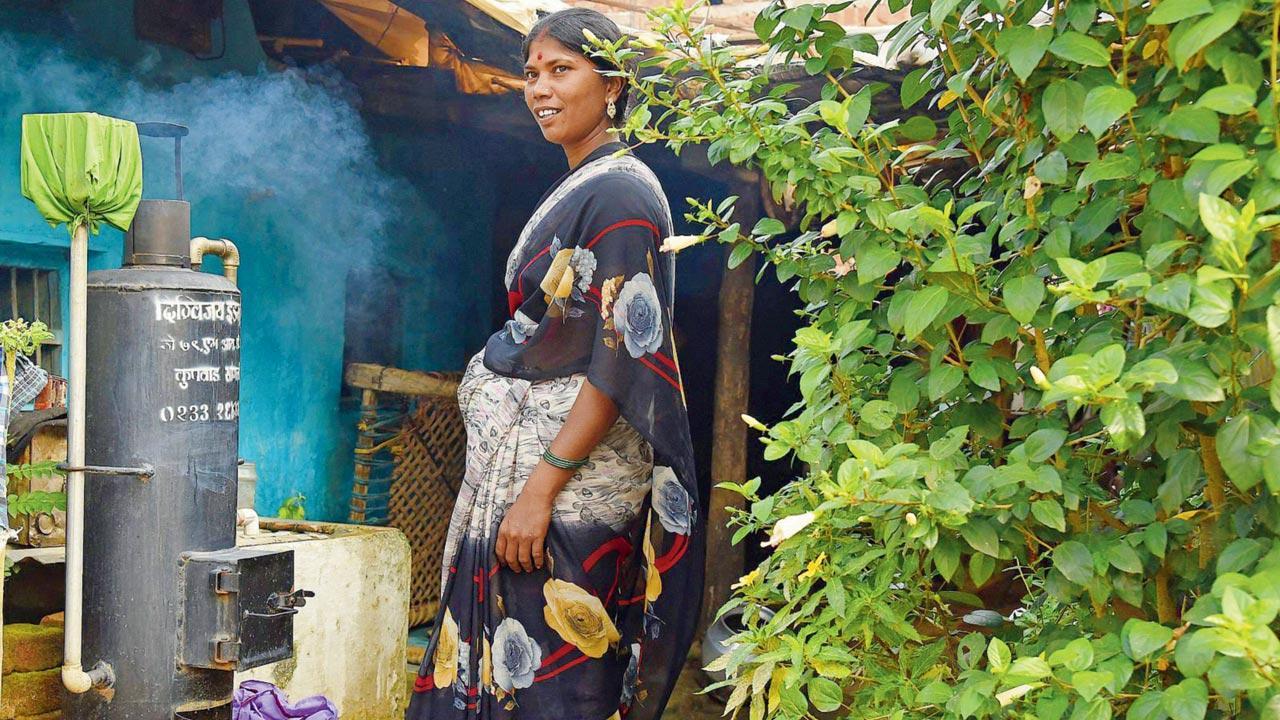
Yamina Chandrashekhar Chilbule, 33, using a water heater, locally known as the bumbb, in Mangrul village in the Bramhapuri, Chandrapur district. The fuel chamber can be refuelled using crop residue, household dry waste, and cow dung cakes. Locals prefer using turati ‘toor daal’ stems. Pics/Dr Anish Andheria, WCT
For 12 years now, the Mumbai-headquartered not-for-profit Wildlife Conservation Trust (WCT) has been working in the landscape to the east of the Tadoba-Andhari Tiger Reserve, in the forest division of Brahmapuri in the Chandrapur district. “Spread across 1,100 sq km, this area is contiguous with the buffer zone of Tadoba, and also Kanhargaon [the last tiger-worthy forest in Maharashtra] to the south, before the forest opens into Telangana,” Dr Anish Andheria, president and CEO, WCT, shares over a phone call.
With the mitigation of human-wildlife conflict at the heart of their work, the WCT has, with the help of the state forest department, been undertaking a rigorous camera trapping exercise in the region since 2011. “When we first started camera trapping in the Brahmapuri division, as well as all the other adjoining tiger-bearing forest blocks of the Chandrapur district [including the Ghodazari and Kanhargaon wildlife sanctuaries], we recorded about 18 tigers,” says Andheria. “But, because of the effective management practices of the forest department and overall emphasis on improving the water sources over the last decade, the population began to increase. Obviously, if an area gets saturated with tigers, they start spilling over. That is how many tigers entered Brahmapuri [from Tadoba].” In the last few years, the numbers have been hovering around 55.
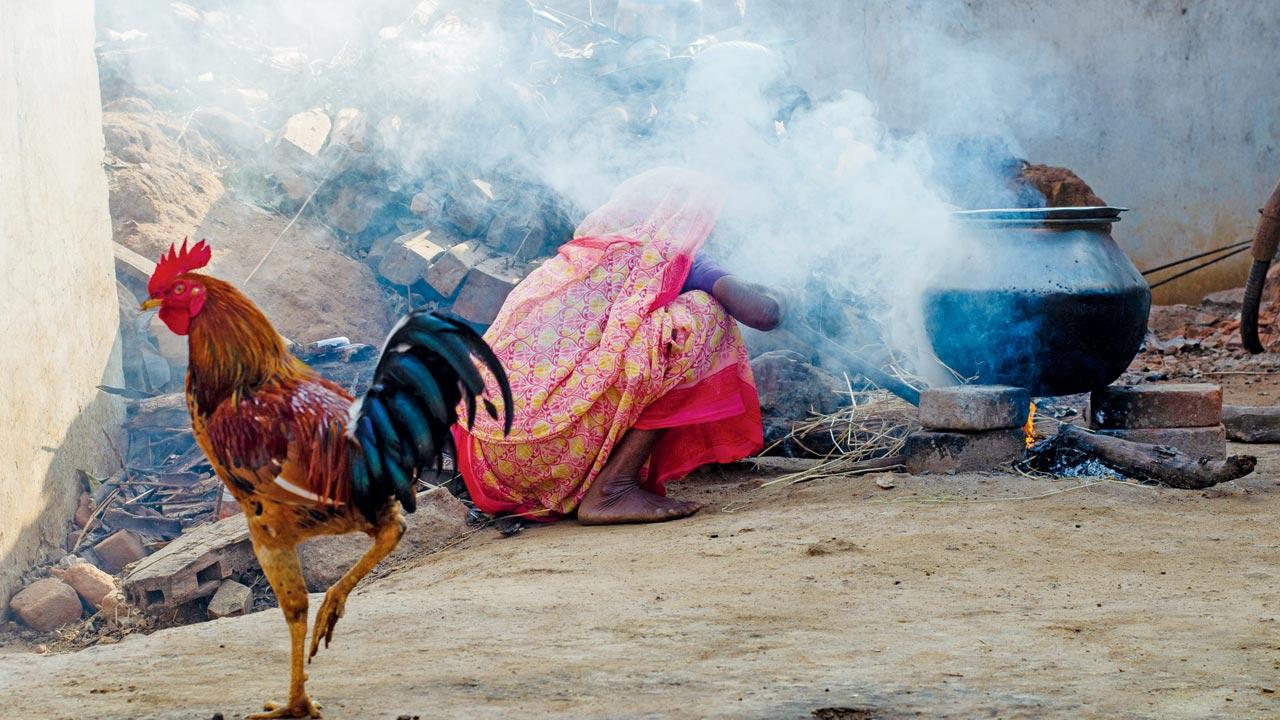 Women who use the chulha are exposed to huge amounts of smoke, which can cause respiratory problems
Women who use the chulha are exposed to huge amounts of smoke, which can cause respiratory problems
While this is good news for Project Tiger—a Central government initiative birthed in April 1973 to remedy the declining tiger numbers—the increase in tiger density means higher chances of man-animal conflict. “Because of fewer tiger numbers earlier, one or two generations had had zero interactions with the animal,” says Andheria. This was no longer the case. The Brahmapuri division is home to 604 villages, each comprising 100 families, which is approximately 500 people per village. “Now think of that many villagers impregnated inside a reserve forest with 55 other tigers, and 25-30 cubs every year!” he tells us.
This background is essential to understanding why the non-profit, which has otherwise been carrying out tiger-monitoring studies, decided to distribute subsidised biomass-fuelled water heaters in households situated within the tiger corridor. The initiative, titled Heater of Hope, recently won the prestigious United Nations Development Programme (UNDP) Mahatma Award for Biodiversity 2023. The simple answer to the question, “Why this initiative?” is, “to reduce the man-animal conflict,” says Andheria. But, there is also a long-winding, circuitous answer, closely linked with environmental and cultural factors in the region.
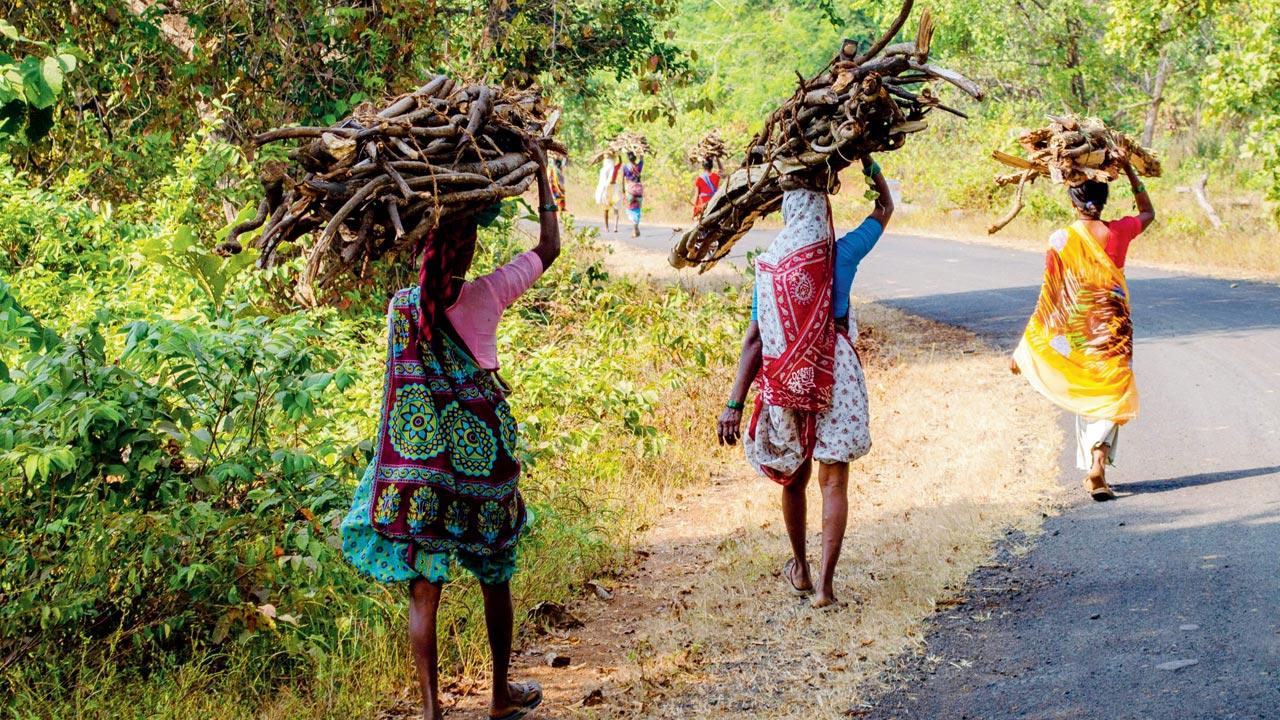
Women have to walk several kilometres to bring firewood from the forest. Apart from the physical labour—they carry bunches weighing anywhere between 15 to 25 kg—there is always a lurking possibility of encountering a wild animal. Pics/Rizwan Mithawala, WCT
“The forest quality in Brahmapuri has been going down over the years,” says Andheria, “because villagers have been heavily relying on forests for fuel [firewood].” The collection of firewood has led to degradation of forests, which, in turn, has caused a drop in other wild animal populations. “So, while the tiger density has increased, the prey density has been reducing significantly, due to which tigers have started attacking cattle.” In the last seven years, more than 5,000 cattle have been killed by tigers. “Simultaneously, attacks on people also increased.” The collection of firewood in these forests, by virtue of the task, also made the people vulnerable to attacks. According to the state’s forest department data, 51 people died in tiger and other wildlife attacks in Chandrapur, in 2022. “This is around four people per month,” says Andheria.
In 2018, WCT’s team carried out an extensive year-long socio-economic survey of 2,000-plus households in 49 villages within Brahmapuri, to find a solution to the conflict issue. The study, which also included psycho-social variables, was followed by in-depth interviews.
 Dr Anish Andheria and Tamanna Ahmad
Dr Anish Andheria and Tamanna Ahmad
“[In our findings] We realised that the government had supplied subsidised cooking gas [LPG] to almost all the families, in the hope that they would stop using firewood,” says Andheria. But while villagers had switched to using LPG cylinders for cooking, a majority of the households still used firewood for heating water. According to their data, LPG use had substituted firewood usage by only 39 per cent, as refuelling the cylinders was still very expensive.
Firewood collection in these villages is primarily a woman’s job, says Delhi-based Tamanna Ahmad, lead, implementation, WCT. Ahmad was part of the research team that conducted the survey. She even spent time in the homes of the villagers in Kitali, Lohara and Chak Jatepar, in the Chimur and Nagbhir blocks of Chandrapur; it helped her build a rapport with the community. While around them, she observed the day-to-day activities of the women. “The woman of the house would fire the chulha first thing around 5 in the morning to heat water, after which she would sweep the floor,” she says. The heated water was used for bathing, washing hands, cooking and drinking. Depending on the requirement, the chulha would be lit several times in the day. “Even during peak summer in Brahmapuri, people prefer heated water to bathe.” This is primarily because of the labour-intensive work that they do in the fields. A hot water bath is the only way to relax their sore bodies.
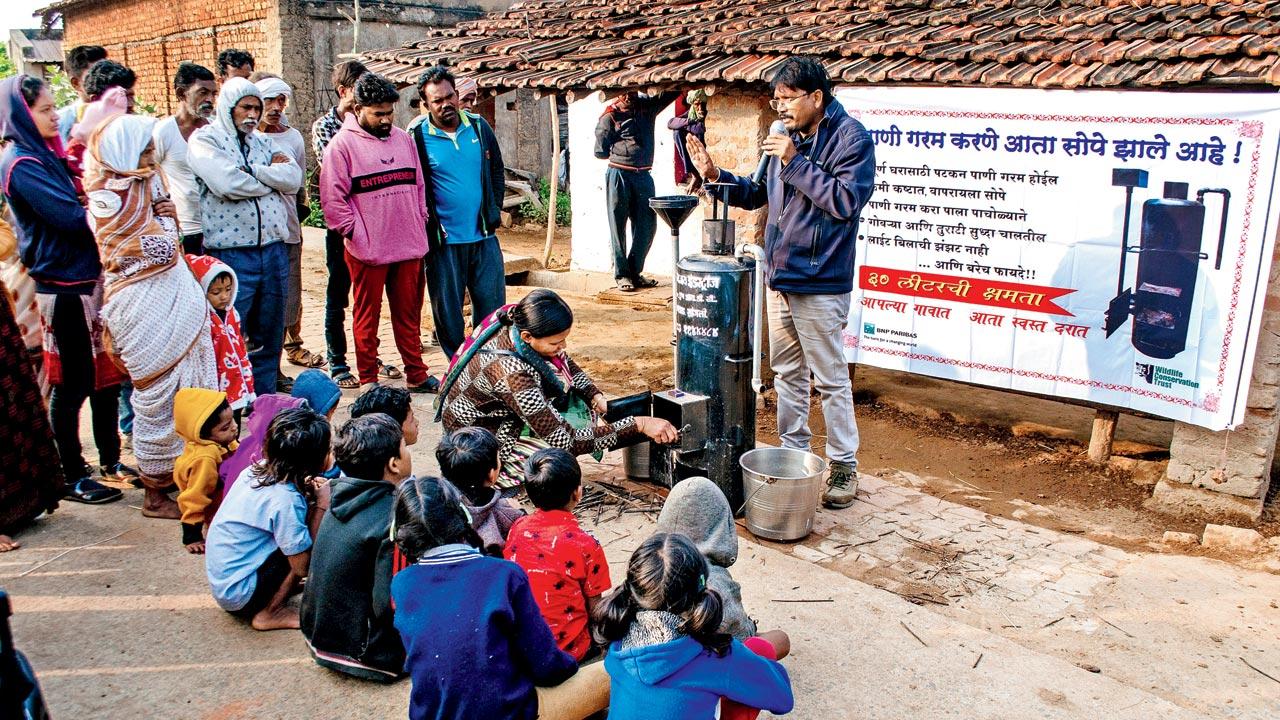
Villagers gather for a bumbb demonstration in Bramhapuri
That the usage of chulhas increases the disease burden, is a given. “Women use a pipe to blow air into the chulha to keep the fire burning, exposing themselves to huge amounts of smoke,” says Ahmad. Solid fuels are known to emit substantial amounts of pollutants, including particulates, carbon monoxide, nitrogen oxides, benzene, formaldehyde, and polyaromatic compounds, leading to respiratory diseases. “Not only did it put the woman of the house at risk, but also those inside
the house.”
It became increasingly clear to the team that to reduce the consumption of firewood, it was necessary to provide a viable and affordable alternative for
heating water.
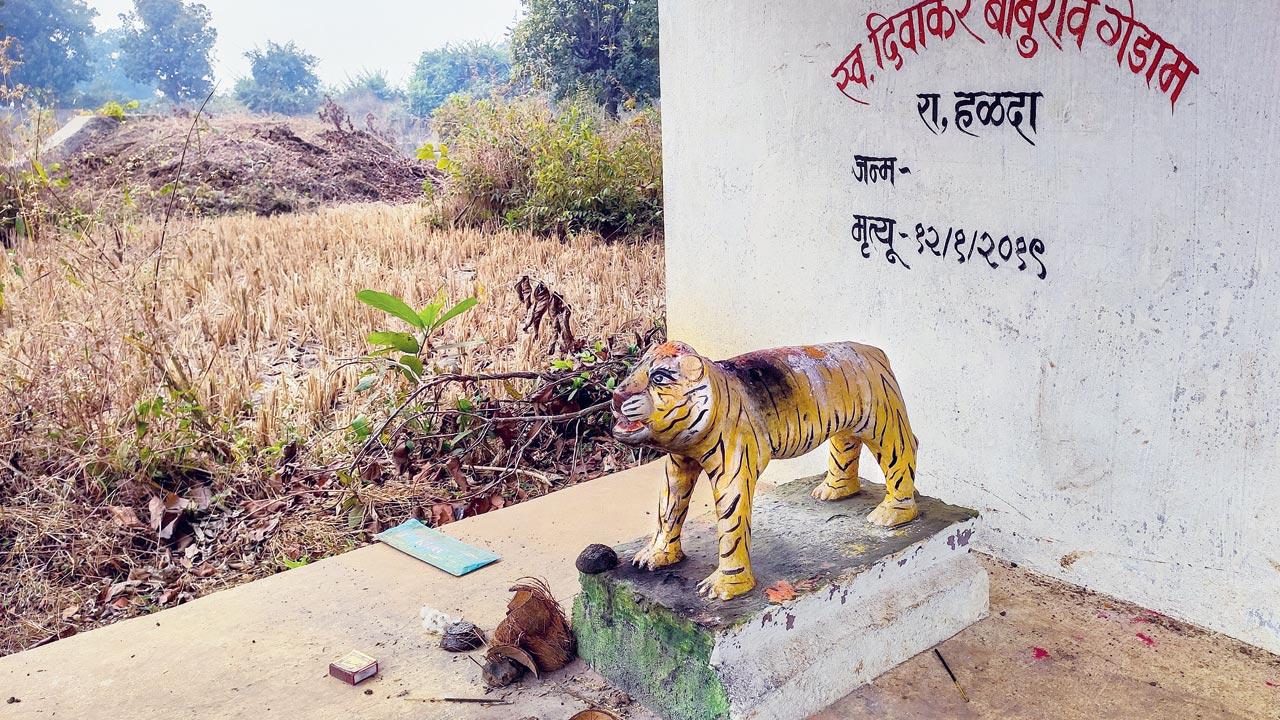 Memorial of man killed by a tiger in Halda village
Memorial of man killed by a tiger in Halda village
Soon after concluding their first survey, Andheria and team started looking for water heaters, which could be distributed at subsidised rates to villagers. “We found a manufacturer in Sangli who made industrial-grade water heaters,” says Andheria. “We worked with the team to re-engineer the heater to meet the requirement of a five-member family.” According to Ahmad, the water heater they designed had a fuel chamber, which could be refuelled using crop residue, household dry waste, turati stems and even cow dung cakes. “It basically eliminated the use of firewood,” she says.
It also had to be cost-effective. The 30-litre water heater was made using cast iron, weighed 50 kg, and cost about Rs 8,000. Villagers could buy it at a cost of Rs 1,800, with the remaining expense being borne by WCT.
Before the initial rollout in 2019, the team carried out studies to understand the requirement for this water-heater on the ground. “We were trying to figure out whether a community-level or individual-level water heater would be better,” says Ahmad, “Based on the psychological parameters we collected data on, we found that these communities were high on individualism, as in, they would prefer owning individual properties as opposed to sharing it collectively.”
The team then approached the more influential families in the village, and convinced them to try it out. WCT also began displaying posters and cloth banners, and conducting demos, magic shows and nukkad naataks (street plays) to highlight the problem of man-animal conflict and why water heaters could help mitigate it. “We would tell them how women are the victims of a lot of tiger-related deaths, as they are at a higher risk of encountering these animals,” says Andheria. The water heater, locally called the bumbb, has since travelled across several villages in the region, through word of mouth. Sarpanches in Brahmapuri have been approaching WCT to carry out awareness drives in their villages.
To understand how fuel consumption has changed in some of the villages that they intervened in, the team has been collecting biannual data. In their first study in 2021, conducted in six villages, they found a 30 per cent reduction in forest visits. “We also noticed an increase in use of cow dung cakes,” says Ahmad. The results of the survey from this year are still being examined.
Meanwhile, the bumbb has already made it to 9,500 homes, is leading to firewood savings of at least 9,500 tonnes and a CO2 emission reduction of 15,200 tonnes annually. “By end of this year, we expect 10,000 households to own one,” says Ahmad.
Mindsets too are changing.
“One of the women we interviewed told us that she wanted the bumbb, because all her girlfriends now owned one, and she didn’t have anyone to accompany her to collect firewood in the forest,” says Ahmad. In a major role reversal, men too, are now taking a shine to the contraption, because of its ease of use; they have been helping women with water-heating duties.
But nothing beats the empowering story of 26-year-old Pallavi Aatram of Nanded village. Ahmad says, “Pallavi was married in May this year, and moved to Bhandara district. When her uncle asked her what he could gift her for her wedding, she said that all she wanted was a ‘bumbb’.”
9,500
Tonnes of firewood saved by villages in Brahmapuri after the bumbbs were installed in households
 Subscribe today by clicking the link and stay updated with the latest news!" Click here!
Subscribe today by clicking the link and stay updated with the latest news!" Click here!










